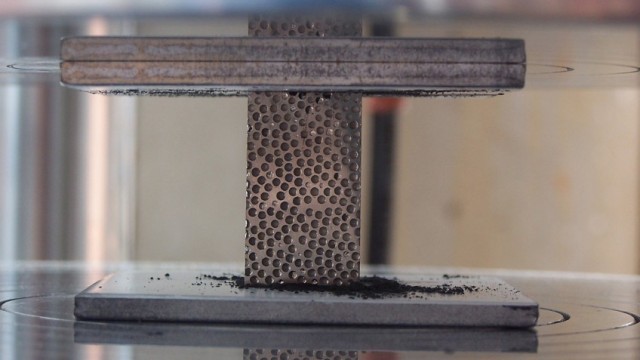Jul 21 2015
A study performed at North Carolina State University (NC State) has revealed that strong yet lightweight composite metal foams not only withstand high impact collisions, but can also block gamma rays, X-rays, and neutron radiation. This latest research could pave the way for using metal foams in medical technology, space exploration, and nuclear safety applications.
 A sample of the composite metal foam developed in Rabiei's research group. Photo credit: Afsaneh Rabiei.
A sample of the composite metal foam developed in Rabiei's research group. Photo credit: Afsaneh Rabiei.
“This work means there’s an opportunity to use composite metal foam to develop safer systems for transporting nuclear waste, more efficient designs for spacecraft and nuclear structures, and new shielding for use in CT scanners,” said Afsaneh Rabiei, corresponding author of a paper on the work and a professor of mechanical and aerospace engineering at NC State.
The strong and lightweight metal foam was initially developed by Rabiei for use in military and transportation applications. However, the researcher also wanted to find out whether the foam could be utilized for space exploration or nuclear applications or whether it could shield against high impact collisions, provide the required structural support, and offer protection against different forms of radiation.
Rabiei and her colleagues later carried out a number of tests to find out the effectiveness of the metal foam in blocking gamma rays, X-rays, and neutron radiation. The performance of this material was then compared against the performance of bulk materials which are being utilized in shielding applications. Samples of the same areal density were used during comparison. This means, the individual samples had equal weight, but different volume.
It was found that high-Z steel-steel was the most effective composite metal foam and suitably protected against gamma rays, X-rays, and neutron radiation. This material mostly contained stainless steel with trace amounts of tungsten, but the structure of the high-Z foam material was altered to ensure that the composite foam containing tungsten was not denser in comparison to the metal foam fully made of stainless steel.
Subsequently, the research team examined the shielding performance against different forms of gamma ray radiation. It is a well-known fact that different source materials emit gamma rays with varied energies. For instance, higher-energy gamma rays are produced by cobalt and cesium, while lower-energy gamma rays are emitted by americium and barium.
The team found that in terms of blocking high-energy gamma rays, the high-Z foam was similar to bulk materials, but was relatively much better at blocking low-energy gamma rays when compared to the bulk materials, including bulk steel. Likewise, the high-Z foam exceeded other materials with respect to blocking X-rays and neutron radiation; however, it was not as effective as the lead material.
“However, we are working to modify the composition of the metal foam to be even more effective than lead at blocking X-rays – and our early results are promising,” Rabiei said. “And our foams have the advantage of being non-toxic, which means that they are easier to manufacture and recycle. In addition, the extraordinary mechanical and thermal properties of composite metal foams, and their energy absorption capabilities, make the material a good candidate for various nuclear structural applications.”
The paper titled “Attenuation efficiency of X-ray and comparison to gamma ray and neutrons in composite metal foams,” appeared in Radiation Physics and Chemistry.
Shuo Chen is its lead author who is a Ph.D. graduate at NC State, and Mohamed Bourham, a professor of nuclear engineering at NC State, co-authored the paper.